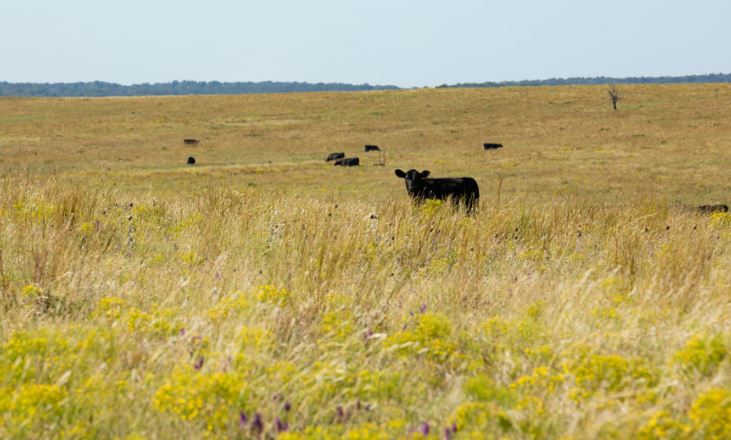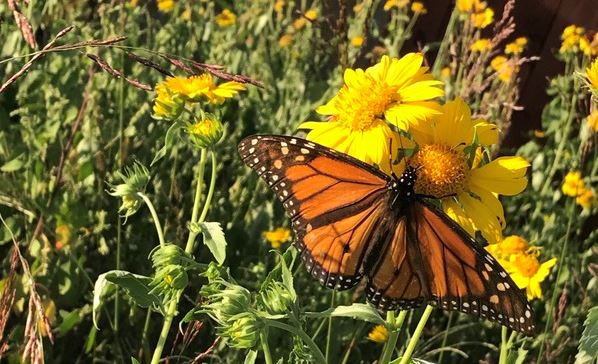 |
We invite you to listen to us on great radio stations across the region on the Radio Oklahoma Network weekdays- if you missed this morning's Farm News - or you are in an area where you can't hear it- click here for this morning's Farm news from Ron Hays on RON.
Let's Check the Markets!
OKC West is our Market Links Sponsor- they sell cattle three days a week- Cows on Mondays, Stockers on Tuesday and Feeders on Wednesday- Call 405-262-8800 to learn more.
Wholesale Boxed Beef Trade finished this past week- higher again- a record once again- Choice Boxed Beef up $9.89 to $377. 45 while Select Beef ended on Friday at $357.13- up $6.10. Click here for the complete report from USDA Market News.
Superior Livestock Auction reports just over 32,000 head of cattle were sold last Thursday on their satellite and online auction platform- prices were called unevenly steady as the country continues to struggle with the volatility from the coronavirus pandemic- click or tap here for a comprehensive rundown of last Thursday's sale.
Today's First Look:
mornings with cash and futures reviewed- includes where the Cash Cattle market stands, the latest Feeder Cattle Markets Etc.
Okla Cash Grain:
Futures Wrap:
Feeder Cattle Recap:
Slaughter Cattle Recap:
TCFA Feedlot Recap:
Our Oklahoma Farm Report Team!!!!
Ron Hays, Senior Farm Director and Editor
KC Sheperd, Associate Farm Director and Editor Sam Knipp, Farm Editor Pam Arterburn, Calendar and Template Manager Dave Lanning, Markets and Production
|
|
|
Oklahoma's Latest Farm and Ranch News
Your Update from Ron Hays of RON
Monday, May 4, 2020
|
Howdy Neighbors!
Here is your daily Oklahoma farm and ranch news update.
|
The full impact of the COVID-19 pandemic has not completely hit the U.S. meat export market but Dan Halstrom, president and CEO of the U.S. Meat Export Federation, said his group is bracing for lower numbers. Halstrom spoke with Radio Oklahoma Agriculture Network Associate Farm Director and Editor KC Sheperd this week.
"It's forced us to be very fluid and creative in how we deal with the market," Halstrom said. "Through March, we haven't seen much of an impact but in April the more concern there is, because the U.S. is seen as the gold standard in terms of a reliable supply partner for Asia and Latin America. So far the disruption has been minimal."
Halstrom pointed out Japan, the largest U.S. beef export customer, had increased purchases by 10 percent through February. He said this is due in large part to the trade agreement with Japan enacted Jan. 1.
In Europe, we are enjoying our exclusive U.S. only quota that went into effect Jan. 1 after many years of struggling with this issue, Halstrom said.
The bad news is Europe is struggling with the COVID-19 impact and their food service industry, much like ours in the U.S., has been hit hard, Halstrom said. Two-thirds of U.S. meat was targeted to the food service industry.
Halstrom said the retail meat market is booming in Europe, and elsewhere, and when food service returns, U.S. meat exports will be ready to meet that demand.
|
|
|
Sponsor Spotlight
Established in 1905 as Oklahoma Farmers Union, AFR/OFU has been a champion for rural Oklahoma for more than 100 years. Today, the AFR/OFU Cooperative provides educational, legislative and cooperative programs across the state and AFR Insurance provides auto, home, farm and life insurance to both rural and urban Oklahomans.
|
Today, Congressman Frank Lucas (OK-03) led a bipartisan letter with 24 of his House colleagues to U.S. Department of Agriculture (USDA) Secretary Sonny Perdue requesting that he provide the findings of the Agency's beef pricing investigation to Congress as soon as possible. Following the announcement of the USDA's Packers and Stockyard Division investigation in August of 2019, Secretary Perdue, extended USDA's investigation last month to determine the causes of divergence between live beef and box prices during the COVID-19 pandemic.
"Beginning in the first few weeks of the crisis, cattlemen have seen prices drastically decline, with cattle futures falling 29% between the month of January and April, all-the-while beef prices increased on market shelves. While we do recognize the complexity of the beef markets generally, the devastating effect this has had on many of our constituents in the last few weeks is clear. This is of great concern to us for a variety of reasons but chief among them being the doubt it casts on our markets as a whole. When market participants begin to believe that markets are not competitive or transparent that suspicion has a dangerous industry-wide ripple effect. That is why we applaud you for expanding the ongoing investigation into the cattle market's reaction to the 2019 plant fire in Holcomb, Kansas to encompass the more recent CV-19 related market concerns. This oversight role the agency plays is an immensely important one that helps ensure that our markets are equipped to function properly," the Members of Congress wrote.
"We are encouraged by the recent steps that the Department has taken to better coordinate with the Commodities Futures Trading Commission (CFTC). We hope that this cooperation yields new insights into the relationship between cattle spot and futures markets. Producers want effective, market-based risk management tools. However, volatility during this pandemic has made market participation difficult to manage and capital intensive
|

Farmers and ranchers may apply to enroll grasslands in the Conservation Reserve Program (CRP) Grasslands, which began March 16. The signup runs through May 15.
"Through this CRP Grasslands signup, farmers and ranchers can protect grasslands, rangelands and pastures, while maintaining the land as working grazing lands," said Scott Biggs, Oklahoma State Executive Director. "The program emphasizes support for grazing operations and plant and animal biodiversity, while protecting land under the greatest threat of conversion or development."
Through CRP Grasslands, participants retain the right to conduct common grazing practices, such as haying, mowing or harvesting seed from the enrolled land. Timing of some activities may be restricted by the primary nesting season of birds.
Participants will receive an annual rental payment and may receive up to 50 percent cost-share for establishing approved conservation practices. The duration of the CRP contract is either 10 or 15 years. FSA will rank applications using a number of factors including existence of expiring CRP land, threat of conversion or development, existing grassland, and predominance of native species cover, and cost.
|

In the latest edition of the Noble News and Views from the Noble Research Institute, Brian Hays, Pasture and Range Consultant and Jeff Goodwin, Conservation Stewardship Leader and Senior Pasture and Range Consultant write about What You Should Be Monitoring on Native Rangelands in May
May is a very important month for native pastures in the southern Great Plains. By the end of this month, approximately 50% of this year's forage production will be produced. Monitoring your native pastures that are being grazed is critical to making sure they are not being over-utilized. As you evaluate your native pastures, you should see some of last year's dead/residual growth still standing in the green new growth. If you do, you are likely stocked properly and are doing a good job with your grazing management. If you do not, now is a good time to re-evaluate your stocking rate and/or make changes to your grazing plan.
MONITORING RAINFALL
May is generally a wet month in Oklahoma and Texas, so monitoring rainfall this month and throughout the year is critical. We recommend using a water year rainfall table. The water year rainfall table allows you to determine the percentage above or below the long-term average that the actual rainfall is at the end of each month. Having this information allows you to make stocking rate adjustments.
|
|
Sponsor Spotlight
Midwest Farm Shows is proud to produce the two best Farm Shows in the State of Oklahoma annually- the Tulsa Farm Show each December and the Oklahoma City Farm Show each April.
They would like to thank all of you who participated in their 2019 Tulsa City Farm Show.
Up next will be the Oklahoma City's premier spring agricultural and ranching event with returns to the State Fair Park June 18-19-20, 2020.
Now is the ideal time to contact the Midwest Farm Show Office at 507-437-7969 and book space at the 2020 Oklahoma City Farm Show. To learn more about the Oklahoma City Farm Show, click here.
|
USDA's Risk Management Agency (RMA) today announced changes to the Forage Seeding and Forage Production crop insurance programs starting with the 2021 crop year. Changes include expanding coverage to new regions and counties, expanding coverage to fall-planted forage and changing the method for loss adjustment.
"These changes will expand coverage to new places, better reflect current agricultural practices and better protect forage producers from losses," RMA Administrator Martin Barbre said. "This will also enable forage producers to better secure loans and provide continuity to their forage production operations."
Specifically, the changes:
Establish coverage of forage seeding for producers in 186 more counties.
Expand coverage to fall-planted forage and align forage seeding cancellation and termination dates with the dates for other fall planted crops in each state.
Revise loss-adjustment procedures to rely upon the number of live alfalfa stems rather than the number of live plants for making loss determinations for forage containing more than 60 percent alfalfa.
These changes are further described in a final rule, now available on the Federal Register at regulations.gov. Interested parties are invited to comment on the rule for 60 days.
|

The loss of milkweed and other nectar plants along the monarch migration route reduces the resilience of the monarch population to predators, parasites, pathogens, and weather events. Environmental stressors and habitat loss have caused recorded declines in monarch numbers since the 1990s.
Radio Oklahoma Ag Network Associate Farm Director, KC Sheperd, spoke with Aimee Hood, the regulatory and scientific engagement management lead at Bayer. She said if producers want to help with the monarchs, the easiest solution is to plant habitat for the monarch butterflies, "They love milkweed, but they also love any flowering plants because they rely on nectar as a sugar source, so if we can plant more of these plants, that makes the monarchs happy."
She says you don't have to have a ton of acres; you can plant habitat in your flower beds, backyards, and pretty much anywhere to attract the butterflies.
To support monarch health, landowners and farmers are encouraged to plant monarch habitat and record their efforts in the HabiTally app, a free mobile app developed by Bayer and The Climate Corporation, and donated to Iowa State University (ISU). Hood said, "Anyone can download this app and then pin where you are and record what you have on your land."
|
The Oklahoma Cattlemen's Association (OCA) released a list of OCA members who sell beef direct to the consumer.
"The COVID-19 pandemic has touched almost every part of our daily lives. The meat supply chain has been disrupted by sickness of employees at packing plants, which has consumers seeking to find beef in a less common way; direct from the ranch." said Mike Weeks, President of the OCA. "We've compiled a list of our members who are selling beef direct in an effort to connect consumers with beef cattle ranchers."
The list is available at okcattlemen.org and OCA's social media channels today and list will be updated frequently.
"We hope this list will be a win for consumers and producers," said Weeks. "Beef producers take pride in the delicious, nutritious protein that they produce. The opportunity to market direct connects beef cattle ranchers and consumers on a more intimate level."
|

COVID 19 Notes- Letter to the President, Smithfield Starts Reopening of South Dakota Pork Plant and Triumph Facing Positive Test Results
The nation's leading farming and ranching member organizations and the meat and poultry industry associations today sent a letter to President Donald J. Trump applauding his leadership in working with members of Congress and federal, state and local officials.
In the Letter- the ag leaders say "This week's Executive Order enacting the Defense Production Act to keep meat plants open is a key first step toward stabilizing the current plant capacity challenge and overcoming other major hurdles facing meat producers. Given our unprecedented times and challenges in many major industries, there's no way to know to what the extent or scope of continued disruptions might be, but we do know that, with the safety and well-being of essential people top of mind, our farmers and ranchers need and want to get their animals to market so we can continue delivering meat and poultry to consumers.
The letter was signed by Zippy Duvall, President, American Farm Bureau Federation, Colin Woodall, CEO, National Cattlemen's Beef Association, Mike Brown, President, National Chicken Council, Neil Dierks, CEO, National Pork Producers Council, Joel Brandenberger, President and CEO, National Turkey Federation and Julie Anna Potts, President and CEO, North American Meat Institute.
Click here for our story and the full text of the letter.
*********************
The digital arm of the Argus Leader newspaper in South Dakota is reporting that the Smithfield Pork Plant in Sioux Falls is starting to do a little work today- "Smithfield Foods in Sioux Falls will partially reopen Monday after being closed for more than two weeks, according to the worker's union.
The meatpacking plant asked about 250 employees to report to its Sioux Falls plant on Monday to staff two departments - ground seasoned pork and night cleanup, according to the United Food and Commercial Workers union local.
The plant has been closed for more than two weeks after an outbreak infected 853 of its 3,100 workers.
According to a ranking put out by the National Pork Board- the Sioux Falls plant is the ninth largest plant in the US, based on the daily number of hogs processed which accounts for 3.9% of the daily capacity in the US before the Pandemic.
*********************
And Finally- the second largest pork processing plant in the US- the Triumph Plant in St. Joseph- apparently continues to operate despite hundreds of workers who have tested positive- a Kansas City TV station reported over the weekend "On Saturday morning, the Missouri Department of Health and Senior Services reported that 359 employees and contract workers of Triumph Foods, who had no related symptoms, have received positive results for COVID-19."
Overall- the current processing capacity in the US is off by over twenty percent- and reports of thousands of hogs have been euthanized in the upper midwest- including in Iowa and Minnesota.
|
|
Our thanks to Midwest Farms Shows, P & K Equipment, AFR Insurance, Oklahoma Farm, Bureau, Stillwater Milling Company, Oklahoma Cotton Council, National Livestock Credit Corporation, Oklahoma Beef Council, Oklahoma AgCredit, the Oklahoma Cattlemens Association and KIS Futures for their support of our daily Farm News Update. For your convenience, we have our sponsors' websites linked here- just click on their name to jump to their website- check their sites out and let these folks know you appreciate the support of this daily email, as their sponsorship helps us keep this arriving in your inbox on a regular basis- at NO Charge!
We also appreciate our Market Links Sponsor - OKC West Livestock!
We invite you to check out our website at the link below too that includes an archive of these daily emails, audio reports and top farm news story links from around the globe.
God Bless! You can reach us at the following:
phone: 405-473-6144
|
|
|